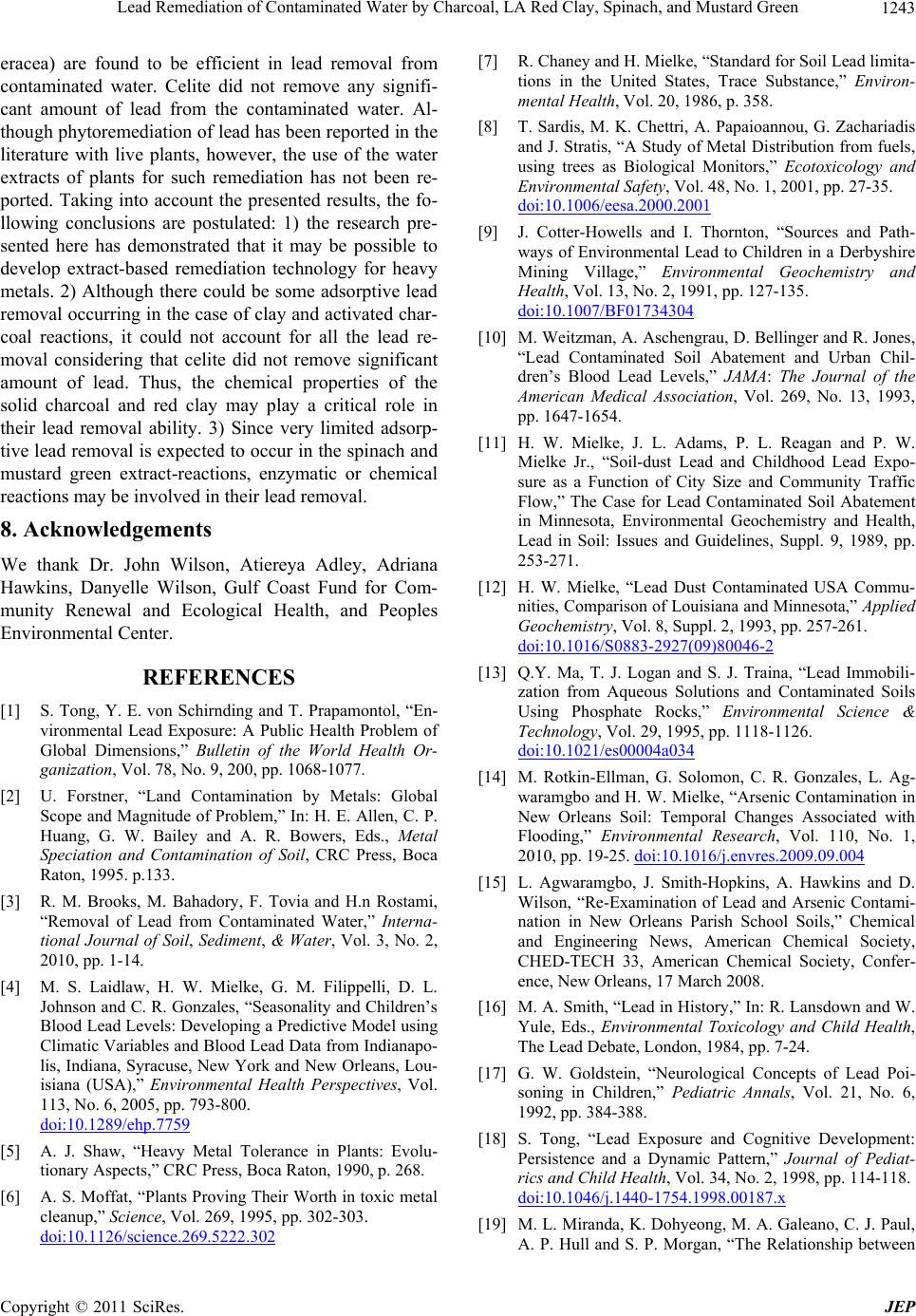
Lead Remediation of Contaminated Water by Charcoal, LA Red Clay, Spinach, and Mustard Green1243
eracea) are found to be efficient in lead removal from
contaminated water. Celite did not remove any signifi-
cant amount of lead from the contaminated water. Al-
though phytoremed iation of lead has been reported in the
literature with live plants, however, the use of the water
extracts of plants for such remediation has not been re-
ported. Taking into account the presented results, the fo-
llowing conclusions are postulated: 1) the research pre-
sented here has demonstrated that it may be possible to
develop extract-based remediation technology for heavy
metals. 2) Although there could be some adsorptive lead
removal occurring in the case of clay and activated char-
coal reactions, it could not account for all the lead re-
moval considering that celite did not remove significant
amount of lead. Thus, the chemical properties of the
solid charcoal and red clay may play a critical role in
their lead removal ability. 3) Since very limited adsorp-
tive lead removal is expected to occur in the spinach and
mustard green extract-reactions, enzymatic or chemical
reactions may be involved in their lead removal.
8. Acknowledgements
We thank Dr. John Wilson, Atiereya Adley, Adriana
Hawkins, Danyelle Wilson, Gulf Coast Fund for Com-
munity Renewal and Ecological Health, and Peoples
Environmental Center.
REFERENCES
[1] S. Tong, Y. E. von Schirnding and T. Prapamontol, “En-
vironmental Lead Exposure: A Public Health Problem of
Global Dimensions,” Bulletin of the World Health Or-
ganization, Vol. 78, No. 9, 200, pp. 1068-1077.
[2] U. Forstner, “Land Contamination by Metals: Global
Scope and Magnitude of Problem,” In: H. E. Allen, C. P.
Huang, G. W. Bailey and A. R. Bowers, Eds., Metal
Speciation and Contamination of Soil, CRC Press, Boca
Raton, 1995. p.133.
[3] R. M. Brooks, M. Bahadory, F. Tovia and H.n Rostami,
“Removal of Lead from Contaminated Water,” Interna-
tional Journal of Soil, Sediment, & Wate r, Vol. 3, No. 2,
2010, pp. 1-14.
[4] M. S. Laidlaw, H. W. Mielke, G. M. Filippelli, D. L.
Johnson and C. R. Gonzales, “Seasonality and Children’s
Blood Lead Levels: Developing a Predictive Model using
Climatic Variables and Blood Lead Data from Indianapo-
lis, Indiana, Syracuse, New York and New Orleans, Lou-
isiana (USA),” Environmental Health Perspectives, Vol.
113, No. 6, 2005, pp. 793-800.
doi:10.1289/ehp.7759
[5] A. J. Shaw, “Heavy Metal Tolerance in Plants: Evolu-
tionary Aspects,” CRC Press, Boca Raton, 1990, p. 268.
[6] A. S. Moffat, “Plants Proving Their Worth in toxic metal
cleanup,” Science, Vol. 269, 1995, pp. 302-303.
doi:10.1126/science.269.5222.302
[7] R. Chaney and H. Mielke, “Standard for Soil Lead limita-
tions in the United States, Trace Substance,” Environ-
mental Health, Vol. 20, 1986, p. 358.
[8] T. Sardis, M. K. Chettri, A. Papaioannou, G. Zachariadis
and J. Stratis, “A Study of Metal Distribution from fuels,
using trees as Biological Monitors,” Ecotoxicology and
Environmental Safety, Vol. 48, No. 1, 2001, pp. 27-35.
doi:10.1006/eesa.2000.2001
[9] J. Cotter-Howells and I. Thornton, “Sources and Path-
ways of Environmental Lead to Children in a Derbyshire
Mining Village,” Environmental Geochemistry and
Health, Vol. 13, No. 2, 1991, pp. 127-135.
doi:10.1007/BF01734304
[10] M. Weitzman, A. Aschengrau, D. Bellinger and R. Jones,
“Lead Contaminated Soil Abatement and Urban Chil-
dren’s Blood Lead Levels,” JAMA: The Journal of the
American Medical Association, Vol. 269, No. 13, 1993,
pp. 1647-1654.
[11] H. W. Mielke, J. L. Adams, P. L. Reagan and P. W.
Mielke Jr., “Soil-dust Lead and Childhood Lead Expo-
sure as a Function of City Size and Community Traffic
Flow,” The Case for Lead Contaminated Soil Abatement
in Minnesota, Environmental Geochemistry and Health,
Lead in Soil: Issues and Guidelines, Suppl. 9, 1989, pp.
253-271.
[12] H. W. Mielke, “Lead Dust Contaminated USA Commu-
nities, Comparison of Louisiana and Minnesota,” Applied
Geochemistry, Vol. 8, Suppl. 2, 1993, pp. 257-261.
doi:10.1016/S0883-2927(09)80046-2
[13] Q.Y. Ma, T. J. Logan and S. J. Traina, “Lead Immobili-
zation from Aqueous Solutions and Contaminated Soils
Using Phosphate Rocks,” Environmental Science &
Technology, Vol. 29, 1995, pp. 1118-1126.
doi:10.1021/es00004a034
[14] M. Rotkin-Ellman, G. Solomon, C. R. Gonzales, L. Ag-
waramgbo and H. W. Mielke, “Arsenic Contamination in
New Orleans Soil: Temporal Changes Associated with
Flooding,” Environmental Research, Vol. 110, No. 1,
2010, pp. 19-25. doi:10.1016/j.envres.2009.09.004
[15] L. Agwaramgbo, J. Smith-Hopkins, A. Hawkins and D.
Wilson, “Re-Examination of Lead and Arsenic Contami-
nation in New Orleans Parish School Soils,” Chemical
and Engineering News, American Chemical Society,
CHED-TECH 33, American Chemical Society, Confer-
ence, New Orleans, 17 March 2008.
[16] M. A. Smith, “Lead in History,” In: R. Lansdown and W.
Yule, Eds., Environmental Toxicology and Child Health,
The Lead Debate, London, 1984, pp. 7-24.
[17] G. W. Goldstein, “Neurological Concepts of Lead Poi-
soning in Children,” Pediatric Annals, Vol. 21, No. 6,
1992, pp. 384-388.
[18] S. Tong, “Lead Exposure and Cognitive Development:
Persistence and a Dynamic Pattern,” Journal of Pediat-
rics and Child Health, Vol. 34, No. 2, 1998, pp. 114-118.
doi:10.1046/j.1440-1754.1998.00187.x
[19] M. L. Miranda, K. Dohyeong, M. A. Galeano, C. J. Paul,
A. P. Hull and S. P. Morgan, “The Relationship between
Copyright © 2011 SciRes. JEP